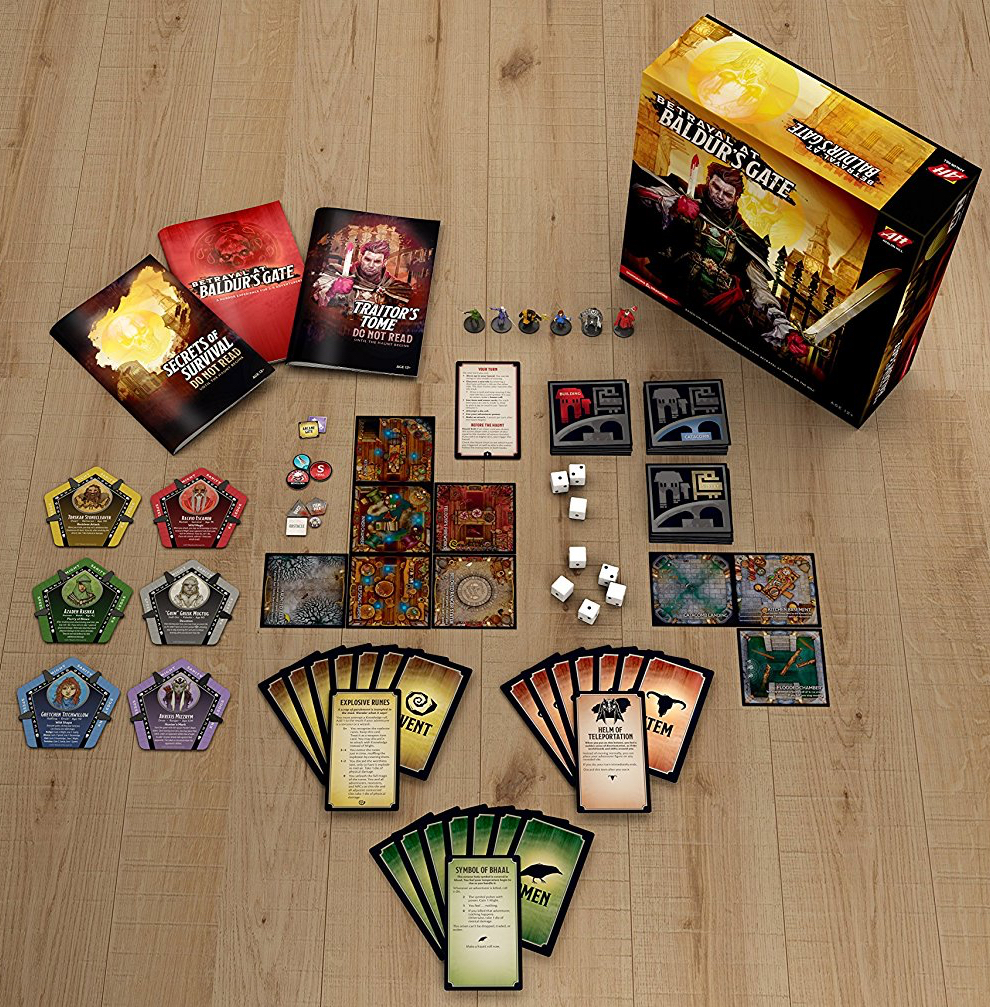Betrayal at Baldur’s Gate (Boardgame)
 Part story, part game, Betrayal at Baldur’s Gate is never the same game twice. Players start the game exploring the city of Baldur’s Gate. About halfway through the game changes into an entirely new experience when one player becomes the traitor and begins to work at cross purposes to the rest of the players. Neither side knows the other’s winning conditions until the contest is over. Betrayal at Baldur’s Gate takes the gameplay of the popular Betrayal at House on the Hill (released in 2004) and blends it together with a strong Dungeons and Dragons theme. The result is a fun, narrative rich, slightly horror-esque delve into the Forgotten Realms.
Part story, part game, Betrayal at Baldur’s Gate is never the same game twice. Players start the game exploring the city of Baldur’s Gate. About halfway through the game changes into an entirely new experience when one player becomes the traitor and begins to work at cross purposes to the rest of the players. Neither side knows the other’s winning conditions until the contest is over. Betrayal at Baldur’s Gate takes the gameplay of the popular Betrayal at House on the Hill (released in 2004) and blends it together with a strong Dungeons and Dragons theme. The result is a fun, narrative rich, slightly horror-esque delve into the Forgotten Realms.
Betrayal at Baldur’s Gate
Publisher: Avalon Hill / Wizards of the Coast
Ages: 12+
Players: 3-6
Time: 60 minutes
(Review copy provided by Wizards of the Coast)
In Betrayal at Baldur’s Gate, players assume the roles of characters exploring the city. As they explore (by turning over tiles representing buildings, streets, and catacombs) they encounter Events, find Items, and experience Omens. Players are represented by nifty painted plastic miniatures and each character card is double-sided with a different choice on each side. Characters are mostly taken from Dungeons and Dragons lore and get a bonus power or effect that bend the rules to give the characters a bit of flavor. For example, the rogue is able to move around more freely, and isn’t as hindered by friends or foes in the same tile.
In the first part of the game, everyone is free to roam however they want, trying to gain items and skills to increase their capabilities. However, as more Omens are found, it becomes more and more likely for something dastardly to occur. At some point, determined by chance, an omen will instigate the second half of the game. The character who found the omen becomes the Traitor, and begins to work against the rest of the players.

Two booklets (one for the Traitor, one for the rest of the players) each contain the story, rules, and goals for fifty different scenarios (making it highly unlikely you will play the same game twice anytime soon – and even then you’re free to hop down the list to a different game.) The traitor player leaves the room and reads up on his or her new abilities and goals for the game while all the other players read about their goals and can strategize together. The two groups come back together and then work through the end game. Note that the two sides may not actually know the goals and/or abilities of the other side until revealed through game play.
Each of the fifty possible story/games are called Haunts. I’m not going to give out any spoilers, but it is pretty obvious looking at the number of little cardboard tokens in the game that many of the Haunts will focus on some sort of combat between the Traitor and the other players. Every character has four stats (speed, might, sanity, and knowledge.) Characters can fight or interact with any of those stats, with speed & might the physical attributes and sanity & knowledge the mental attributes. Lose a physical contest and you need to lose speed or might points (or both). Lose a mental encounter and you will lose sanity or knowledge. You get to pick which points you lose, but if any of your stats reach zero you are eliminated from the game. Note, that as you get “damaged” your attributes get lower so any damage you take makes you weaker in the long run. (This is particularly important if players are banding together to take down a stronger Traitor.)
All that being said, many haunts will come down to the Traitor accomplishing some other goal (or the other players accomplishing something else.) For example (I’m making this one up) but the traitor might need to gather items to complete a ritual within a time limit while the other players try to stop the same (by taking up too much time or eliminating the items.) So not all Haunts are combat focused, but combat is a common occurrence in the game. (You can even forgo doing 2 points of damage to someone in order to steal an item in their possession.) To top things off, there are even a few Haunts that end up with NO traitor and the players are instead challenged to complete a set of tasks before the time runs out and the big bad guy completes his evil plans.

Verdict:
I’m normally not a huge fan of traitor-type games. I like my games entirely cooperative or decidedly non-cooperative. (I do like team games, but again prefer to know where everyone stands.) However, while the “traitor” isn’t known to anyone (including the traitor) until the event happens, I am satisfied with the traitor mechanic. Everyone putters around trying to find good and interesting gear, preparing for the moment when the traitor is revealed. Then it is a game of decidedly good guys vs the bad guy(s.) There isn’t that mechanic where a player may or may not be helping the team, it is clear to all just who is on what side.
Like its predecessors, the Betrayal at Baldur’s Gate experience will rely on the story being told. If you enjoy a good dose of story and plot in your game, it should satisfy you. If you are more about the rules and the “crunch” of a game, then it may not be your cup of tea. While the Haunts have all been playtested thoroughly, situations can arise where the poor traitor is selected right when he (or she) is standing in a room full of other players so the game ends almost immediately. Other times things might arise such that the game out stays its welcome as the situation is such that either side has a hard time reaching their game winning condition. Both of those situations are outliers, however. The Betrayal at House on the Hill games at times jumped right into the Haunt early in the game, but the Haunt and traitor mechanism has been slightly changed so that Baldur’s Gate players can expect the Haunt to begin right around that 20 to 30 minute mark.
As the newest incarnation of the House on the Hill series, Betrayal at Baldur’s gate is a great jumping off point. The tie-in to Dungeons and Dragons helps to make the Haunts a bit more personal so this is definitely the edition to buy if your gaming group has some familiarity with the brand. The characters in this edition also have a bit more powerful or at least more “fun” special abilities, which gives this edition a slight nod over the past ones.
Kid Factor:
This is a text-heavy game and it is worse if you end up being the traitor. I suppose you could play such that a younger player is swapped out if they end up being the traitor but that would be a bit contrived. As for maturity level, it is a horror-style game so I wouldn’t bring young kiddies into the game. There isn’t anything scary or yucky from a graphical standpoint but some of the haunts/items/events can be on the more intense side. That said, I didn’t find any inappropriate language or “adult” content in the games I played.





Discussion Area - Leave a Comment